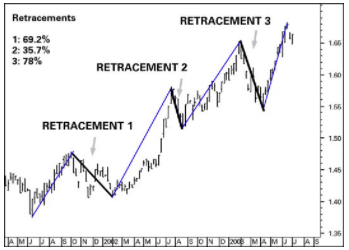
The Fibonacci retracement is based on mathematician Leonardo Fibonacci’s sequence of key numbers dating back to the 13th century. Leonardo Fibonacci identified a series of numbers, which seem to constantly occur in nature.
Numbers like:
0,1,1,2,3,5,8,13,21,34 and so on.
The numbers in the sequence are found by adding the two numbers before:
For example
0+1=11+2=33+2=5
And so on. There is a fascinating theory behind these numbers and their
sequencing. In this blog we will focus on how to use the Fibonacci sequence in trading.
A Fibonacci retracement, in technical analysis, is created by taking two extreme points (usually the top and the bottom) and
dividing the vertical distance by the key FIBONACCI ratios of:
- 23.6%
- 38.2%
- 50%
- 61.8%
- AND 100%
Once the levels have been identified, we can then draw horizontal lines to identify the possible RESISTANCE and SUPPORT levels.
The key Fibonacci ratio is found by dividing one number in the series by the number that follows it. For example, 21 / 34 = 0.6176 and 55 / 89 = 0.6179. Therefore 61.8% usually referred to as the GOLDEN RATIO.
Equally the 38.2% is considered as an important technical level amongst the most popular ratios.
When used properly Fibonacci retracements can indicate where, when and in what direction a position could be placed.
Example: When looking at a pair such as the EUR/USD, and we observe that the 38.2% retracement or equally 61.8% level marks an important strong support then the pair would be considered in a BULLISH TREND and the
Fibonacci support would be considered an interesting level to enter a LONG position. A break of this level could signal a sell-off or be used as a signal to enter a SHORT position.
Fibonacci levels also form a base for well rounded and more sophisticated technical studies such as Trading patterns, or Elliot Waves.
The Elliot Waves principle
The idea behind the Elliott Wave principle is that all price movements of any pair have TWO SEGMENTS.
The IMPULSE WAVE
And THE CORRECTIVE WAVE
The IMPULSE WAVE, as determined in the ELLIOTT WAVE principle, is one in which the ‘crowd’ wants to take the price in a trend. (This of-course is considering that the correct way to look at the price development
of a pair is through the lens of crowd psychology - therefore impulse)
Each kind of wave is made of a given number of parts:
In the impulse wave, three parts move into the direction of the trend, whilst alternating with two parts that move in the opposite direction.
In the corrective wave, two parts move against the main trend whilst one moves with it.
If a bull market reaches a new high in five waves, instead of three, and also goes down in five waves, instead of three, then we are witnesses to the beginning of a MAJOR BEAR MARKET.
We will often observe three clear waves upwards, although sometimes a move has more upwaves than three. The three waves rule is the only model in which markets move and cannot be considered as rigid.

Counting waves can be an elaborate and time-consuming process. Make sure to devote the necessary time to study and understand the trend. And remember THE TREND IS YOUR FRIEND.
Finior Capital Limited (“the Company”), a Company limited by shares that is formed and registered under the Laws of the Abu Dhabi Global Market (“ADGM”) under license number 000001143, authorized and regulated by the Financial
Services Regulatory Authority (“FSRA”) under reference number 170018.
This publication is for information purposes only and does not constitute or intend to provide any professional advice to the reader. The information contained in this publication may not be suitable for all the
readers and should not solely rely on this publication for any investment decision. Finior Capital Limited does not accept any responsibility or liability for any investment decision to be undertaken by the reader as a
result of this publication. The reader should conduct his own suitability and shall take the decision based on his/ her own knowledge, judgement and experience of the financial markets. Finior Capital Limited do not provide
any services to retail clients and the intention of this publication is not to provide any professional advice to its reader(s). All the investment products are subject to market risk.
